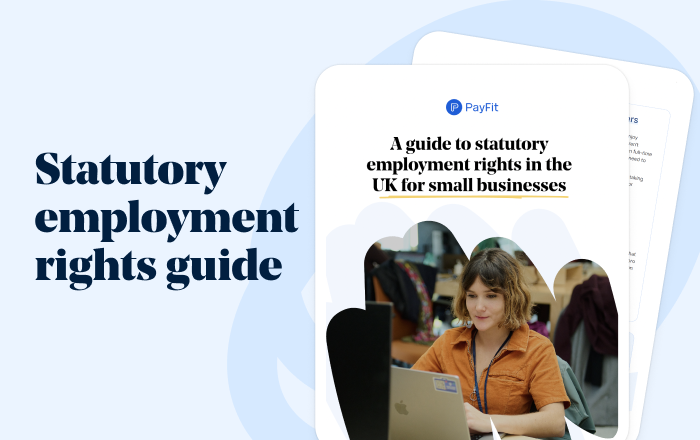✨ Health insurance, now in PayFit - learn more
💷 All the rates & thresholds you need to know for 25/26...right here
✨ The Payroll Journey: Start, Scale & Succeed Globally - learn more
✨ Health insurance, now in PayFit - learn more
💷 All the rates & thresholds you need to know for 25/26...right here
✨ The Payroll Journey: Start, Scale & Succeed Globally - learn more

Here are the most important points for busy managers and business leaders to keep in mind:
Constructive dismissal occurs when an employee resigns because you, the employer, have committed a fundamental breach of their employment contract.
The burden of proof is on the individual, who must prove the breach was serious enough to justify their resignation.
Constructive dismissal compensation is split into a Basic Award (based on years of service) and a Compensatory Award (based on financial loss).
The Compensatory Award is capped at a maximum of one year’s salary, or a statutory limit (£118,223 for the 2025/26 tax year), whichever is lower.
Prevention is the best strategy. This relies on clear policies, trained managers, and a fair working culture built on trust.
Running a growing business involves managing different risks. While you focus on finance and operations, your greatest risk, and asset, is your people. Breakdowns in the employment relationship can be incredibly costly. And one of the most complex risks is a claim of constructive dismissal.
Constructive dismissal isn’t a typical dismissal. Rather, it is when an employee feels forced to resign because of the employer’s conduct. If a claim succeeds at an Employment Tribunal, the award for constructive dismissal compensation can be significant, and damage both your finances and reputation.
For managers and leaders in the UK, understanding this area of employment law is a critical part of managing your team and protecting your business.
This article explores what constructive dismissal is, how compensation is calculated, and the key steps you must make to prevent claims. This is a complex topic, and this guide provides the foundational knowledge you need.
It is crucial to understand that someone being unhappy at work is not automatically cause for constructive dismissal. The law sets a high bar.
To succeed in a claim, an individual must demonstrate two things. First, that their employer’s actions (or failure to take actions) constituted a repudiatory or fundamental breach of contract, that is, one that severely undermines the core purpose of the agreement between the parties. Second, that they resigned in response to that, and did not wait too long to do so.
The legal test often hinges on an implied term in every contractual agreement: the duty of mutual trust and confidence. Many successful cases are based on the employer’s conduct destroying this trust and confidence.
A fundamental breach is a serious one. It must go to the very core of the contractual agreement, showing that the employer no longer intends to be bound by its terms.
Examples of conduct that could constitute a fundamental breach include:
Unilaterally cutting a staff member’s salary, removing significant benefits in kind, or changing their role significantly without agreement.
Failing to provide a safe working environment, or ignoring serious health and safety concerns.
Ignoring formal grievances or complaints of bullying, harassment, or discrimination.
Demoting an individual for no valid reason.
Falsely accusing an individual of misconduct.
A single, serious incident can be enough.
A claim is not always built on one single event. Often enough, it is made up of a series of smaller incidents. Each one on its own might not be a fundamental infringement of the employment agreement. However, the ‘last straw’ doctrine allows the worker to rely on the cumulative effect of conduct.
The final incident, while perhaps minor, becomes the ‘last straw’ that, following the previous conduct, amounts to a fundamental breakdown of trust. This makes these kinds of cases highly fact-specific, and dependent on the person’s entire experience, even over a long period of time.
If an employee wins their case, the tribunal will order the employer to provide a reparation. This is calculated in the same way as a standard unfair dismissal award, and is split into two parts.
The Basic Award is designed to reward the individual’s loyalty and long service. It is identical to the calculation for statutory redundancy pay (SRP) for voluntary redundancy, and is calculated using a fixed formula based on:
The individual’s age.
Their gross weekly pay (currently capped at £719).
Their length of service (in complete years, currently capped at 20) – a factor that becomes more significant after many years of work.
The formula uses these the following multipliers:
1.5 weeks’ pay for each year of service, aged 41 or over.
1 week’s pay for each year of service, aged 22 to 40.
0.5 week’s pay for each year of service, aged under 22.
To give an example of the steps involved in the calculation, let’s imagine an employee who is 45 years old and has 10 complete years of service. Their actual weekly pay is £900.
Apply the pay cap: Their pay (£900) is over the statutory limit, so the calculation must use the cap of £719.
Calculate the years over 41: The employee is 45, so their last 4 years of service were over age 41. Therefore, 4 years x 1.5 = 6 weeks.
Calculate the years from 22 to 40: The remaining 6 years of service were in this bracket. Therefore, 6 years x 1.0 = 6 weeks.
Finally, calculate the Basic Award: (6 + 6 weeks) x £719 => 12 x £719 = £8,628.

UK statutory employment rights guide
The Compensatory Award is typically the larger part of the constructive dismissal compensation. Its purpose is to compensate the employee for the actual financial losses they incurred as a direct result of the dismissal.
This primarily covers loss of earnings for the time the employee is out of work. It can also include the loss of future salary and benefits, as well as pension contributions.
A tribunal will assess what is just and equitable based on the employee’s losses.
However, there is a maximum limit on the Compensatory Award. It is the lower of:
52 weeks’ of the employee’s gross pay.
The statutory cap, which changes almost every year (£118,223 for the 2025/26 tax year).
This significant financial risk is why preventing a claim is so vital.
An employee cannot just resign and file a tribunal claim the next day. They must follow a specific process.
Usually, an employee must first try to resolve the issue internally. This means lodging a formal written grievance with their employer.
This step is critical. It gives you, the employer, a chance to investigate and potentially fix the problem. If an employee resigns without raising a grievance, a tribunal may reduce any reparation they are awarded.
Before an employee can lodge an employment tribunal claim, they must first contact the Advisory, Conciliation and Arbitration Service, ACAS. In doing so, they will trigger a process called Early Conciliation.
ACAS provides a free, impartial Early Conciliation Service to see if a settlement can be reached without a full legal hearing. An ACAS conciliator will therefore speak to both sides to explore options.
This offers a key opportunity to resolve the dispute with the help of a neutral professional. Many cases are, in fact, resolved at this stage.
If conciliation fails, the individual has a limited time to submit their official ET1 claim form. This will launch the formal tribunal process.
This stage is adversarial, public, and expensive. It involves exchanging documents, preparing witness statements, and attending a hearing. You will absolutely need professional legal advice from an employment solicitor or a qualified legal team. Your partnership with experienced solicitors who have expertise and practical experience in this area of employment law will be critical. And their advice will be invaluable.
The best way to avoid paying constructive dismissal compensation is to prevent a claim from ever arising. This requires proactive management and fair, consistent processes.
Have clear contracts and policies: The employment contract and handbook and corporate policy are your foundation. They must be clear, current, and legally compliant.
Train your managers well: Line managers are your first defence. Train them to handle difficult conversations, manage performance fairly, identify stress, and respond to staff concerns. This training and experience is critical.
Take grievances seriously: Never ignore a complaint. Have a formal grievance process, and follow it every single time. Investigate promptly, impartially, and thoroughly. Document every step.
Communicate and consult: If you need to make significant changes to an employee’s working conditions, such as their hours, location, or wage, you must consult with them first. This is a fundamental aspect of employment relations. Forcing changes, on the other hand, is a classic breach.
Focus on employee health: Proactively support your employees’ mental and physical well-being and health. Failing to make reasonable adjustments or to support a struggling employee can form part of a case against you.
Keep meticulous records: Document everything, including performance reviews, 1-to-1 meetings, return-to-work interviews, and investigations. In a dispute, clear, unequivocal records are your best ally.
Technology provides the consistency growing businesses need. Modern HR and payroll software acts as a central system of record, ensuring payroll compliance, and securely recording employment agreements, policies, pay history, and HR KPIs. This provides vital evidence and an indisputable audit trail for any claim in relation to terms, treatment, or pay.
An integrated platform ensures your payroll is accurate and on time, as a fundamental aspect of your contractual obligations. This automation prevents the exact kinds of problem that can lead to claims. Moreover, it also builds trust by giving your team self-service access, freeing up your team to focus on the more human aspects of support.

The time limits are very strict. The individual must contact ACAS to start Early Conciliation within three months (less one day) of their resignation date (their final day of work, and often the end of their statutory notice period).
A standard unfair dismissal is when the employer ends the contract without a fair reason or by following an unfair process. A constructive dismissal is when the employee ends it because of actions taken by the employer. If the tribunal agrees it was a constructive dismissal, then it will almost certainly be considered an unfair dismissal too under the Employment Rights Bill.
To claim constructive unfair dismissal, an individual usually needs to have provided at least two years of continuous service. However, this two-year rule does not apply if the reason for the contract infringement is ‘automatically unfair’. This includes discrimination, whistleblowing, or resigning because of a health and safety danger. This is a key exception for all managers to know about.
The UK government’s website provides official, clear guidance on constructive dismissal for employers and for employees. This is an authoritative starting point for your basic obligations.
In fact, never try to manage a claim alone. An employment solicitor can provide professional advice on the strength of the case, help you manage the ACAS process, and represent you at a tribunal. This kind of legal partnership is essential. The solicitor will, of course, need documentary evidence to defend you. Considering this, our payroll services are designed to work seamlessly with your HR and legal teams, and our HR software features will help you manage the record-keeping that supports this entire process.

Employee handbooks give new and existing employees the chance to access important information about your company and its policies. Learn more.

Understand voluntary redundancy, its legal requirements, best practices, impacts for UK businesses, & considerations for HR, finance & business leaders.

Our guide helps managers understand UK redundancy rights & efficiently handle redundancy, calculate pay, ensure compliance & avoid costly tribunal claims.

This article provides guidance on the redundancy process, to help UK employers understand their obligations and the rights of their employees.

Contract terminations aren’t easy. This guide covers what to do as an employer when you have a redundancy, settlement agreement, death or non-starter.